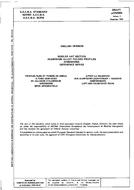Category
Recently Viewed Products
-
 UL 1100
UL 1100
$502.00$301.20 -
 ASD-STAN prEN 2060
ASD-STAN prEN 2060
$16.01$9.61 -
 UL 1004-6
UL 1004-6
$502.00$301.20 -
 ASD-STAN prEN 2002-016
ASD-STAN prEN 2002-016
$39.62$23.77 -
 SMPTE 145
SMPTE 145
$50.00$30.00
UL 1034
$631.00 $378.60
Burglary-Resistant Electric Locking Mechanisms
| Published by | Publication Date | Number of Pages |
| UL | 05/18/2011 | 92 |
UL 1034 – Burglary-Resistant Electric Locking Mechanisms
Please note: All interim revisions for this edition available at time of your purchase will be included.
Burglary-Resistant Electric Locking Mechanisms
UL 1034
1 Scope
1.1 These requirements apply to the construction, performance, and operation of burglary-resistant electric locking mechanisms and their related devices, such as control units, control switches, and power supplies, and the like used to secure and release doors.
1.2 A burglary-resistant electric locking mechanism shall be rated according to the three elements used to determine its maximum effectiveness:
a) Static strength rating of 500 pounds-force (2224 N), 1000 pounds-force (4448 N), or 1500 pounds-force (6673 N). See 55.2.1.
b) Dynamic strength rating of 33 foot-pounds-force (45 J), 50 foot-pounds-force (68 J), or 70 foot-pounds-force (95 J). See 55.3.1.
c) Endurance rating of 100,000 or 250,000 cycles. See 38.2.1.
A burglary-resistant electric locking mechanism shall be rated with its maximum static strength, dynamic strength, and endurance.
1.3 A burglary-resistant electric locking mechanism is intended to be used in conjunction with an access control system or a manual-release mechanism. A burglary-resistant electric locking mechanism shall be constructed so that it either does not interfere with egress through the door or other opening cover that it is used to control, or its locking action shall be capable of being released as required by the authority having jurisdiction if an emergency egress is required.
1.4 These requirements do not pertain to the fire-retardant classification of a door and releasing-device assembly.
1.5 The term “product” as used in this standard refers to all types of burglary-resistant electric locking mechanisms.
1.6 A product that contains features, characteristics, components, materials, or systems new or different from those covered by the requirements in this standard, and that involves a risk of fire or of electric shock or injury to persons shall be evaluated using appropriate additional component and end-product requirements to maintain the level of safety as originally anticipated by the intent of this standard. A product whose features, characteristics, components, materials, or systems conflict with specific requirements or provisions of this standard does not comply with this standard. Revision of requirements shall be proposed and adopted in conformance with the methods employed for development, revision, and implementation of this standard.
Product Details
- Edition:
- 6th
- Published:
- 05/18/2011
- Number of Pages:
- 92
- Note:
- This product is unavailable in Ukraine, Russia, Belarus
Related products
-
UL Subject 1204
$250.00$150.00Add to cartOutline of Investigation for Parts Cleaners (Outline, 11/19/2010)
standard by Underwriters Laboratories, 11/19/2010 -
UL 98
$502.00$301.20Add to cartEnclosed and Dead-Front Switches
Published by Publication Date Number of Pages UL 02/12/2016 0 -
UL Subject 2011
$250.00$150.00Add to cartOutline for Factory Automation Equipment (Outline, 5/1/1995)
standard by Underwriters Laboratories, 05/01/1995 -
UL 970
$897.00$538.20Add to cartStandard for Retail Fixtures and Merchandise Displays
Published by Publication Date Number of Pages UL 02/20/2020 0



